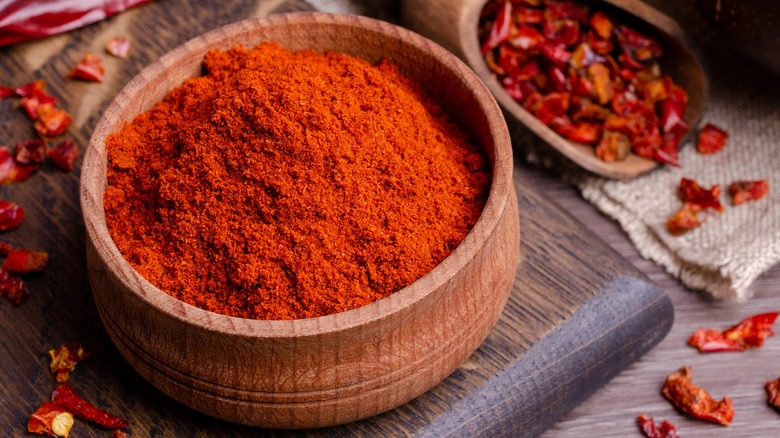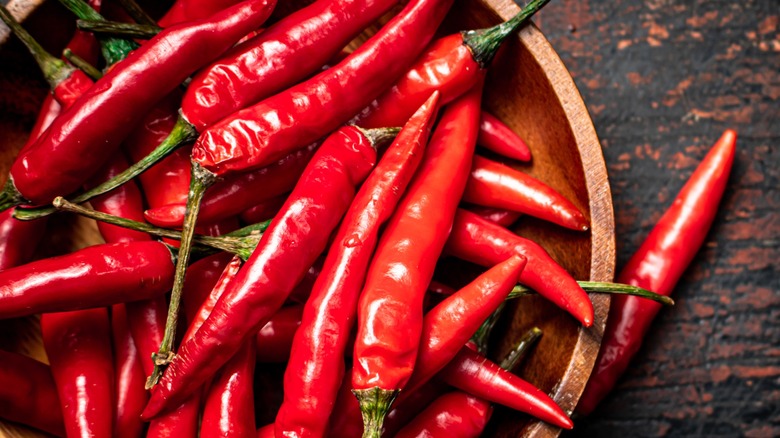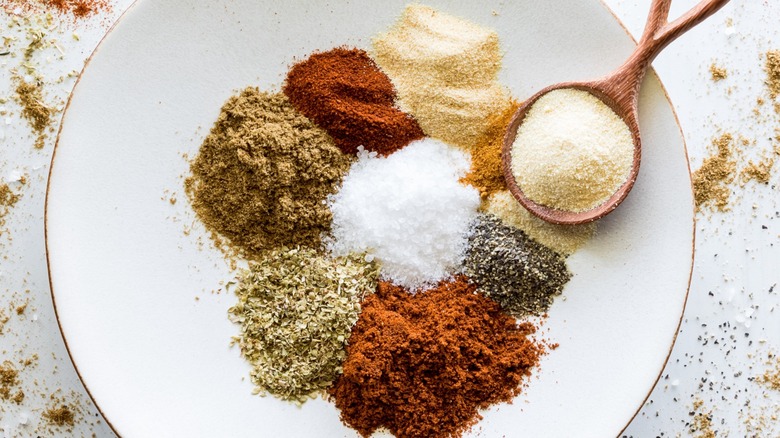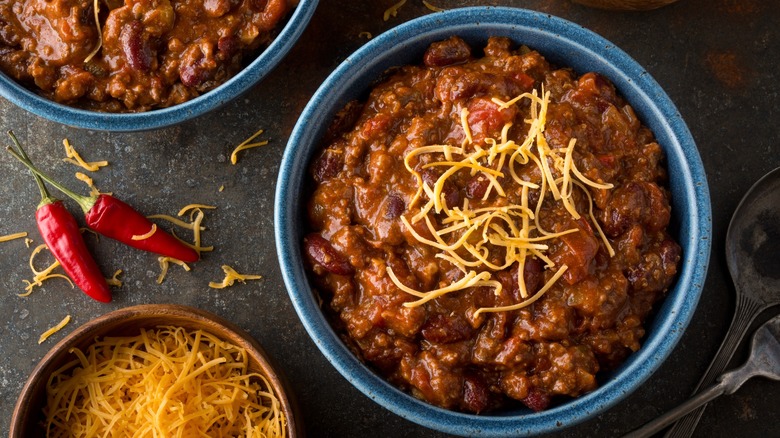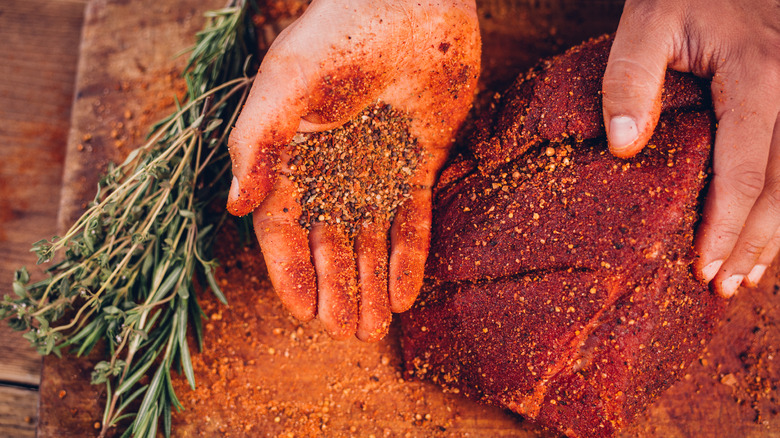What's The Difference Between Cayenne And Chili Powder?
Cayenne and chili powder are both essential elements of spice racks in many kitchens, but how many home cooks can honestly tell what kind of difference using them is going to make in a recipe? The two ingredients frequently get thought of interchangeably as ways to bring some hot pepper flavor and spice to a recipe, and they'll often get used together in the same dish, further blurring the lines of which spice is doing what.
But there are actually pretty major differences between cayenne and chili powder, not just in how they taste, but in how they are made. While they can be used in similar recipes, they only do the same thing in the vaguest sense. In the simplest terms, cayenne is about heat and chili powder is about flavor. A little cayenne can go a long way in making your dish extra spicy — the kind of heat even lovers of spicy foods will feel — but it doesn't have much flavor on its own.
Chili powder, on the other hand, really isn't that hot, and it's actually a blend of different spices and ground peppers that is meant to act as a seasoning. It brings a variety of complex warm and tangy tastes to any dish it's added to, and those flavors can vary by brand, as no two mixes are necessarily the same. So, given that these two spices are more unique than they appear, how do you use them?
What is cayenne?
The cayenne powder you use as a spice is the ground version of just one thing: fresh cayenne peppers. These peppers are native to South America, specifically the northern region around modern-day French Guiana, and the city of Cayenne from which the pepper gets its name. Cayenne is a long, thin red pepper that grows up to five inches in length and is similar in appearance to the larger fresh arbol chile.
Coming from the Capsicum annuum species group, they are directly related to other types of spicy chiles such as jalapeños. Almost all cayenne peppers are consumed in powder form, being dried and ground before use. Cayenne is also commonly used to make red pepper flakes, however, not all spices using that label are made up of 100% cayenne. Cayenne peppers are quite spicy, and even a small amount will add a decent amount of burn to a recipe.
While popular in Latin American cuisine around where it originated, cayenne is now a staple spice found all over the world, being common as far afield as India and China. In the U.S., it provides the base for many popular hot sauces, especially Louisiana sauces like Tabasco and Crystal. But no matter where it's used, the primary purpose of cayenne is to bring extra spice to a dish.
What is chili powder?
Chili powder is not a specific spice, but a category of seasoning blends that include a variety of different herbs and spices. It gets its name from chili the dish, specifically the original chili con carne of Mexico and Texas, as the spices in chili powder were commonly used in those recipes. As a product, commercially produced chili powder goes all the way back to the 1890s when it was invented at a Texas restaurant called the Phoenix Saloon.
The owner bottled and sold the powder, and that brand is actually still available today under the name Gebhardt's Original Eagle Brand Chili Powder, although the recipe has since changed from the more simple, original mix of dried ancho chiles, oregano, cumin, and black pepper. Chili powder is now an extremely common spice blend sold by pretty much every major brand you can find at the supermarket, although part of the confusion is that it's usually stocked with the spices rather than with the dry rubs or meat seasoning mixes that it is actually more similar to.
Chili powder often contains cayenne as part of the mix, but it is only a small portion of most recipes. While each blend varies, chili powder is frequently made with cumin, paprika, oregano, pepper, onion and garlic powder, as well as chile varieties beyond cayenne such as dried ancho or chipotle powder. While made for chili originally, it is now an all-purpose seasoning that's especially popular in Southwestern and Mexican cooking for use in dry rubs, fajitas, or elotes.
Cayenne is an extra spicy pepper that gives meals a kick
Cayenne is likely to be one of the hottest spices in your kitchen, and it is the go-to choice when you want to add heat to almost any dish. Cayenne peppers average between 30,000 and 50,000 heat units on the Scoville Scale. This makes them very similar in heat to a serrano pepper, and up to ten times as spicy as a jalapeño.
The powder can be added in small dashes to bring some subtle warmth to a recipe or spice mixture, but if you bring it to the forefront of a meal, like as a dry rub on hot chicken, you are likely going to feel the burn. Thankfully, cayenne's direct relationship to the spiciness of a recipe makes it easy to adjust, so you can customize the spice of any dish it's used in with minimal impact on the rest of the meal.
Since chili powder sometimes contains cayenne, it can also be a little spicy, but the mix of other ingredients really mellows out the heat. Other powders like hot paprika or ancho chile can also bring a little heat of their own, but it's minimal compared to that of cayenne. Overall, cayenne powder is about eight times hotter than chili powder on average, so you shouldn't count on chili powder to be a significant source of heat, and all but the most spice-sensitive eaters shouldn't have a problem with it.
Chili powder is a spice mix with complex, earthy flavors
Because of its origins as a spice mixture for chili con carne, chili powder is all about the flavor it brings, not the heat. It's taste has an instantly recognizable Tex-Mex character to it, with that mix of subtle heat, warm spice from cumin, earthiness, and a slight fruity tang. The mix of peppers in chili powder is going to determine some of its more noticeable characteristics.
More cayenne means more heat, while paprika-forward blends will be more smoky and sweet, and those based around dried chiles will have more notes of earth, charred coffee, and dried fruit like raisins. No matter the mix, chili powder should be a one-stop shop for big Southwestern and Mexican flavors that can season a dish all by itself. Cayenne, on the other hand, has almost no flavor of its own, the overwhelming sensation it brings is just heat and spice.
It does have a slight fruitiness to it, but it's barely noticeable and won't impact the flavor much. While this may seem like a downside, it actually makes cayenne extremely versatile and explains why it's so commonly used. By bringing heat but little flavor, it can mix well with almost any food or other spice mixture without ruining the balance of the recipe. It is essentially a dial you can turn up or down to your preferred spice level without having to add or subtract other elements while you cook.
Swapping one spice for the other will require adjustments
Because of the large difference in both heat and flavor, cayenne and chili powder can not be directly substituted for one another. If a recipe calls for chili powder or an alternative to chili powder, you are best off trying to approximate a mix using herbs, cumin, and paprika, with just a little cayenne. Likewise, if the recipe needs a cayenne substitute, chili powder won't bring enough heat, so hopefully you have another hot pepper source like hot sauce or gochujang paste, which won't taste exactly the same but will still be plenty spicy.
The places where you'll want to use chili powder are when cooking meat dishes, beans, and hearty soups and stews that call for robust spices. It's a common part of taco seasoning for ground beef or chicken, and can also be nice rubbed onto seafood like grilled shrimp or tilapia. Cayenne is better in a wider variety of dishes, from meat to veggies and even desserts, because of its mild, versatile flavor.
Beyond its heat, cayenne can also help bring out other flavors more by activating taste receptors, much like salt does. As long as you think a dish would work well spicy, cayenne can be a very useful way to enhance a recipe's flavor and add depth. While chili powder and cayenne are quite different from one another, both are mainstays of any kitchen and are spices you'll never run out of uses for.
